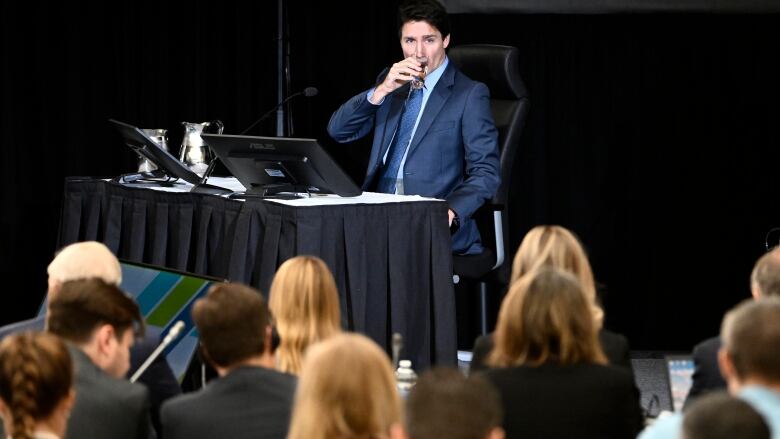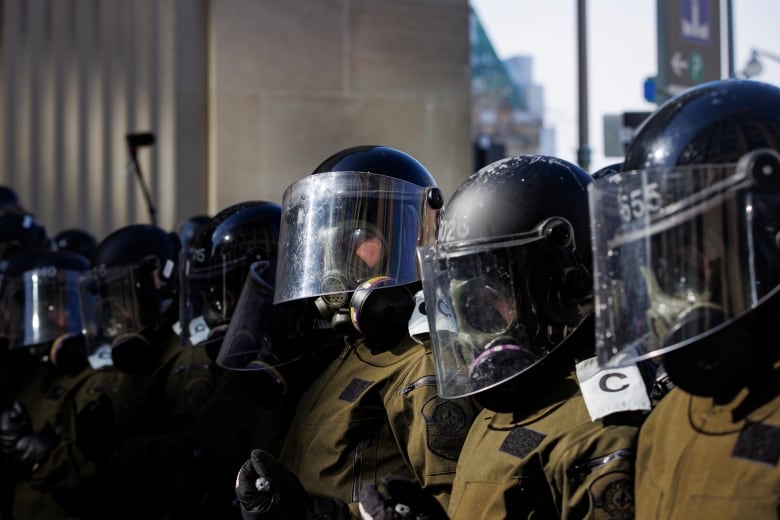Prime Minister Justin Trudeau took the stand at the Emergencies Act inquiry here's what we learned
Trudeau's highly anticipated appearance ended six weeks of live testimony

The live testimony portion of the Public Order Emergency Commission cameto a close on Friday when Prime Minister Justin Trudeau took the stand. Hiskeenly anticipated appearance before the commission inquiry offered manytelling moments and pointed criticisms.
The commission was launchedto examine the government's invocation of the Emergencies Act to handle the anti-vaccine mandate protests that swarmed the downtown streets of the nation's capital last winter.
As commission counsel Shantona Chaudhurypointed out Friday morning,the commission had heard mountains of evidence beforeFriday but was missing one importantperspective thatof theprime minister who invoked the Emergencies Actback in February.
Here arefive key takeaways from his testimony.
Has the 'Kraken' been unleashed?
One line of questioning by Chaudhury focused onwhether the prime minister worried that invoking the act, even for a shorttime, would make future governments more likely to use it.
"But do you worry about the floodgates aspect of this, that having done this, you've now maybe unleashed the Kraken?" she asked the prime minister.
Citing past demonstrationsbyIndigenous and environmental groups,Chaudhury said the act of protest is often a messy affairthatcaninvolve interference with critical infrastructure.
"So what stops this from being used against that?" she asked.
In response, Trudeausaid invoking the act wasn't something his government was eager to do.
Trudeau said that future governments "are likely to look at this experience" and decide that it's not worth invoking the act although laws are on the books to guide its use and ensure thresholds are met.
"It would be [a] worse thing for me to say, even though the thresholds have been met, even though it is needed and necessary, we're not going to do it because someone might abuse it or overuse it in the years to come," he said.
"When there's a national emergency and serious threats of violence to Canadians, and you have a tool that you should use, how would I explain it to the family of a police officer who was killed?
"Or a grandmother who got run over trying to stop a truck or ...a protester who was killed?"
Criticism of the OPS Feb. 13 plan
The prime minister was dismissive when asked about a plan the Ottawa Police Service (OPS) had to clear the protests.
As the commission had heard previously, the Ottawa Police Service, the Ontario Provincial Police and the RCMP had come together to craft an operational plan around Feb. 13.
"We heard in testimony here that there was a plan on the 13th that the Ottawa Police Servicepulled together," he said. "I would recommend people take a look at that actual plan, which wasn't a plan at all."
Trudeau said the plan involved using liaison officers to shrink the perimeter of the Ottawa protest "a little bit," but key features of the plan such as how police officers would be deployed and what resources would be needed were left "to be determined later."
"It was not, even in the most generous of characterizations, a plan for how they were going to end the occupation in Ottawa," he said.
Review the plan? 'We can't'
Sujit Choudhry, counsel for the Canadian Constitution Foundation, didn't let the prime minister's comments about the OPS plan gounchallenged.
Pointing tothe plan, he noted that the document had been heavily redacted.
"It's within your legal authority to instruct your counsel to remove these redactions for the sake of the transparency of this commission," he said."Sir, would you reconsider that request?"
The Government of Canada objected to Choudhry's question, arguingthat any decision to lift those redactions would haveto be carefully considered.
"Prime minister, can I put it to you this way?" Choudhry asked. "You said we should read the plan, but I think you'd agree we can't."
Trudeau says interpretation of 2 acts that matters
Trudeau also spoke about the Canadian Security Intelligence Service (CSIS), its mindset and the challenges it faced during the protests.
In an interview with commission counsel that took place before he testified in person, Trudeau said CSISdidn't have the "right tools, mandate or even mindset" to deal with the protesters.
A key point of contention during the inquiry has to do with how Canadian laws specifically the Canadian Security Intelligence Service Act and the Emergencies Act define threatsto nationalsecurity.
The declaration of a public order emergency under the Emergencies Act relies on the definition of threats to the security of Canada contained in the CSIS Act.
That definition citesharm caused for the purpose of achieving a "political, religious or ideological objective," espionage, foreign interference or the intent to overthrow the government by violence.
In past testimony to the inquiry, the head of CSIStestified he doesn't believe the protest met the definition of a national security threat under the CSIS Act but saidthe Emergencies Act's definition is broader.
Chaudhury pressed the prime minister to statewhether the demonstrations constituted such a threat under the CSIS Act.

"Those words in the CSIS Act are used for the purpose of CSIS determining that they have authority to act against an individual, a group or a specific plot ... for example," Trudeau said.
But the decision to invoke the Emergencies Act ultimately falls on the government, not CSIS, he said.
And while one act leans on the definition laid out in the other, Trudeau said,CSISwas only one institution among many includingthe RCMP, Transport CanadaandImmigration, Refugees and Citizenship Canada offering inputonthat decision.
On Friday, Trudeau said "the context and the purpose" of the two lawsare"very different." He said his government would review the definition of a national security threatdifferently from "the deliberately narrow frame that CSIS is allowed to look at."
"There has been a bit of back-and-forth at this commission on whether these words are different, or can be read differently, or are broader when they're used in a public order emergency than [when] they're used for the CSIS," the prime minister said. "It's not the words that are different. The words are exactly the same in both cases.
"The question is, who's doing the interpretation? What inputs come in and what is the purpose of it?
"And the purpose of it for this point was to be able to give us special temporary measures, as defined in the Public Order Emergency Act,that would put an end to this national emergency."
What constitutes a peaceful protest?
Pointing to a call Trudeau had with then-Conservative Party interim leader Candice Bergen, Chaudhury brought up the importance of balance between allowing people opposed to government policies to be heard and setting a precedent that says a blockade on Ottawa's Wellington Street can change those policies.
"Using protests to demand changes to public policy is something that I think is worrisome," the prime minister said initially.
Trudeau soon clarifiedthat statement, saying a protest against a governmentdecision to shut down a safe injection site would also constitute advocating for a change in public policy.
The usual way of protesting, he said, is to persuadevotersthat a government policy is wrong enough voters to convince governments to change course. Suchprotests, he said,can be effectivein creating change in a democracy.
"But there is a difference between occupations and, you know, saying we're not going until this has changed in a way that is massively disruptive and potentially dangerous," Trudeau said.
















_(720p).jpg)


 OFFICIAL HD MUSIC VIDEO.jpg)
.jpg)



























































































